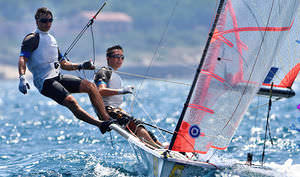

- Products
- Catalogs
- News & Trends
- Exhibitions
Double-handed sailing dinghy 49er skiffregattadouble-trapeze
Add to favorites
Compare this product
fo_shop_gate_exact_title
Characteristics
- Crew
- double-handed
- Type
- skiff
- Use
- regatta
- Trapeze
- double-trapeze
- Sailing dinghy class
- 49er
- Other characteristics
- asymmetric spinnaker
- Length
4.88 m
(16'00" )
Description
Mackay Boats have been building the 49er since it became an Olympic class before the 2000 Sydney Olympics. During this time our boats have gained a reputation for the top workmanship, attention to all details - large and small- and service on this strict One Design boat.
One of the team from Mackay Boats usually attends the class World Championships and other major regattas to ensure our boats retain their premium reputation.
Mackay Boats built the new class moulds for the boats in 2009 which are now used by all builders worldwide. Construction changes were made at the same time to improve the stiffness and longevity of the boats and the wings underwent a significant upgrade and are now pinned in place instead of sitting on slideing tracks as previously done.
The 49er class
The 49er is a 16ft long double trapeze skiff designed by Julian Bethwaite. It was chosen in 1996 to be first used in the 2000 Sydney Olympics. The 49er has been sailed in every Olympics since 2000 and has been again selected as the skiff for the 2016 Olympics in Brazil.
The boat features distinctive wings 9ft wide to allow the crew to achieve maximum leverage and hold the huge sail area supported on a carbon fibre One Design mast made by Southern Spars.
"With a huge sail area for such a small boat, 639 sq. feet, the 49er can sail faster than the speed of the wind.
*Prices are pre-tax. They exclude delivery charges and customs duties and do not include additional charges for installation or activation options. Prices are indicative only and may vary by country, with changes to the cost of raw materials and exchange rates.





